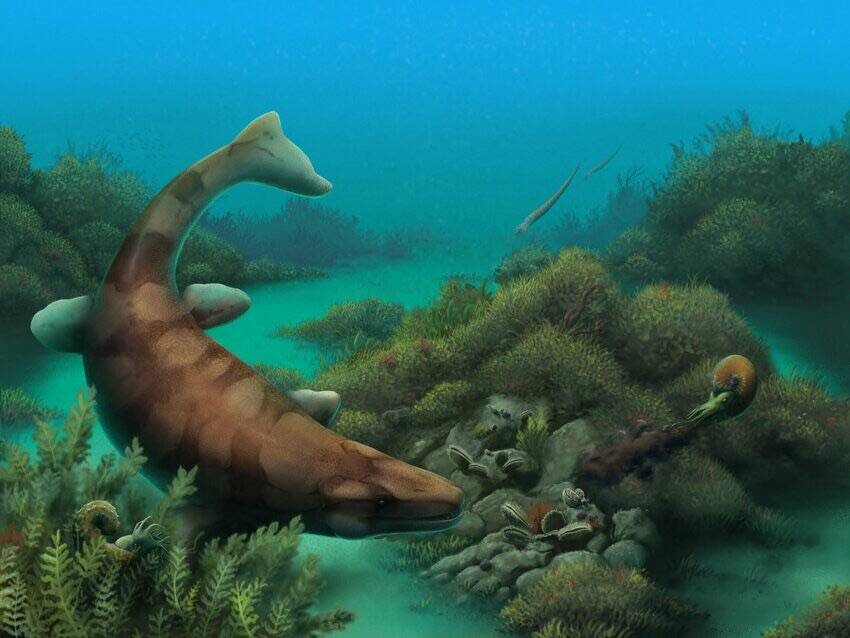Globidens alabamaensis had unique, globular teeth that were perfectly suited for crushing the shells of turtles and mollusks.

Nathan Dehaut/Journal of Paleontological SciencesAn artist’s recreation of Globidens alabamaensis.
Scientists recently announced the discovery of several fossils from a massive mosasaur with giant, mushroom-shaped teeth in Texas. Among the finds were two adult jaw fragments that show off the sea beast’s globular teeth — and demonstrate just how powerful this prehistoric creature was.
The creature in question is known as Globidens alabamaensis, a type of mosasaur that once dominated the shallow seas during the Late Cretaceous period (100.5 to 66 million years ago). G. alabamaensis was first discovered back in 1912, but in the century since, only a handful of specimens have been unearthed. Now, this latest discovery is shedding new light on the ocean lizard’s lifestyle.
Two Mosasaur Jaw Bones Found In The Ozan Formation Of Texas

Journal of Paleontological SciencesThe two jaw bones hold unique, globular teeth.
The discovery of these fossilized jaw bones was detailed in a study published in the Journal of Paleontological Sciences in August 2024. Per the report, the specimens were found in the Ozan Formation in northeastern Texas by a private fossil hunter in 2023.
They were discovered within a deposit dating back to the Campanian Age (83.6 million to 72.1 million years ago). One of the jaw fragments holds 12 teeth, while the other holds six.
Each tooth is roughly an inch long, and they all boast a unique, rounded shape that would have made them perfectly suited for crushing the shells of turtles, mollusks, and other sea creatures. What’s more, based on the presence of a tooth germ along the gumline of one jaw, scientists believe that mosasaurs, like sharks, shed and replaced teeth throughout their lives.

Journal of Paleontological SciencesA close-up view of the tooth germ embedded in the jaw.
Bethany Burke Franklin, a marine paleontologist who was not involved with the study, told Live Science that this evolutionary adaptation of mosasaurs’ teeth also allowed the reptiles to coexist with other predators.
“The adaptation was likely influenced by an overabundance of cephalopods,” Franklin said. “Multiple species could coexist because they were not taking up the same resources. [Mosasaurs] were some of the most rapidly evolving predators of the time. They filled niches that were left behind by the other large marine predators — there were huge chasms in the food web.”
So, what exactly were mosasaurs?
New Insights Into The Lives Of Mosasaurs During The Late Cretaceous Period

Dmitry Bogdanov/Wikimedia CommonsAnother artist’s depiction of Globidens alabamaensis.
Mosasaurs were massive marine reptiles that thrived during the Late Cretaceous period. They were apex predators of the seas, closely related to modern-day lizards. With streamlined bodies, powerful tails, and paddle-like limbs, these carnivorous creatures were fast and efficient swimmers.
Some mosasaurs had sharp, conical teeth, enabling them to catch and swallow prey whole. They primarily fed on fish, ammonites, sea birds, and even other marine reptiles. However, G. alabamaensis, with its rounded teeth, ate shelled creatures like turtles, prehistoric cephalopods, clams, and scallops.
Some mosasaurs could stretch up to 50 feet in length, but G. alabamaensis grew to be 20 feet long.
Mosasaurs, including G. alabamaensis, vanished from the record during the mass extinction event at the end of the Cretaceous period alongside the dinosaurs, likely due to dramatic environmental changes triggered by an asteroid impact.
After reading about the discovery of these prehistoric “sea monster” jaw bones, learn about the megalodon, the largest shark to ever live. Then, read about seven strange sea creatures.





